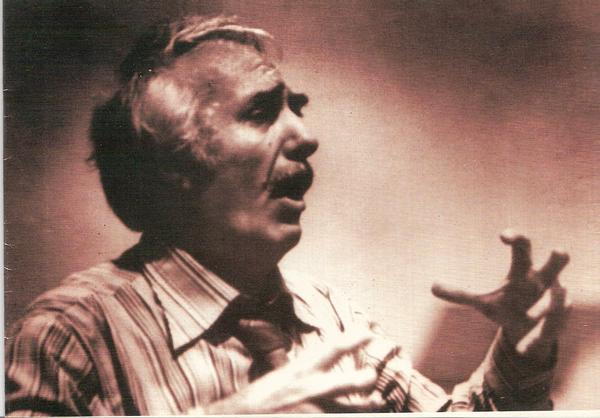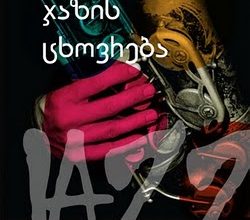
classical, piano music
ტრეკლისტი:
- Piano Concerto #1 (195o)
- Piano Concerto #2 (1975)
- Piano Concerto #3 – Youth (1973) *
- Piano Concerto #4 (1985)
* – #3 თავიდან, თავისი მოკლე, კონცერტინოს ფორმის გამო, არ იყო გაყვანილი ოფიციალურ საკონცერტო ნუმერაციაში, თუმცა ახლა მას უმეტესად მესამე საფორტეპიანო კონცერტს უწოდებენ. / #3 wasn’t first assigned the number due to its short, concertino form. Yet now it is commonly known as Piano Concerto #3.
როდესაც ვფიქრობ სხვადასხვა ერების კლასიკური მუსიკის ესთეტიკაზე, მთავარ განმსაზღვრელ კრიტერიუმად საფორტეპიანო მუსიკას მივიჩნევ ხოლმე. რათქმაუნდა, შეგიძლიათ არ დამეთანხმოთ, მაგრამ მეც ჩემი არგუმენტები მაქვს: 1) საფორტეპიანო მუსიკაში თითქმის ვერასოდეს დამალავ მელოდიურ ხარვეზებს ზედნადები ატმოსფეროთი. 2) საფორტეპიანო მუსიკაში განსაკუთრებით მკაფიოდ გადმოიცემა ეთნოსისთვის დამახასიათებელი მუსიკალური დინამიკა და რიტმულობა. 3) ვინაიდან ფორტეპიანო ერთ-ერთი ცენტრალური კლასიკური ინსტრუმენტია, საფორტეპიანო მუსიკის ნიმუშები ყველა ერის კლასიკურ მუსიკაში დიდი რაოდენობით მოიძებნება, რაც აადვილებს სხვადასხვა ერების კლასიკურ ღირებულებებს შორის მსგავსებისა და განსხვავებების შეფასებას.
ამიტომაც ძალიან მიხარია, რომ ქართული საფორტეპიანო მუსიკის კვლევისას ბევრ ღირებულსა და ორიგინალურს მივაგენი. არაა გასაკვირი, საუკეთესო ნიმუშები ქართულ ფოლკლორულ ფესვებზე და ტემპერამენტზეა ამოზრდილი, მაგრამ ამ ყველაფრის დახვეწილად თავმოყრასა და დამუშავებას დიდი საკომპოზიტორო ნიჭი სჭირდება, რომელიც საბედნიეროდ ქართველ კლასიკურ კომპოზიტორებში უხვად მოიპოვებოდა. საბჭოთა თაობის ბევრი კომპოზიტორი საზრდოობდა ფოლკლორით: მაგ. სულხან ცინცაძე, ალექსანდრე შავერზაშვილი, სულხან ნასიძე და სხვ. მაგრამ ქართული ფოლკლორის კოლორიტი და დინამიზმი განსაკუთრებულად მაინც ოთარ თაქთაქიშვილის პირველ ორ საფორტეპიანო კონცერტში სჩანს.
პირველი საფორტეპიანო კონცერტი იწყება რაღაც საოცარი ფოკლორული თემით, რომელიც საბედნიეროდ, მთლიანი ნაწარმოების ლაიტმოტივი ხდება. ნახევარი საათის განმავლობაში ეს თემა ბევრნაირად მუშავდება, ხშირად თაქთაქიშვილისთვის მახასიათებელი ქრომატიული გადასვლებით. ამ მთავარი მოტივის გარდა კონცერტში ბევრი ძალიან ლამაზი თემაა; მთლიანად კონცერტი კი თავისი ექსპრესიით და მელოდიური სიმსუბუქით ჩაიკოვსკის პირველ საფორტეპიანოს მაგონებს და სიხალასით თავისუფლად დაუდგება გვერდზე. მოკლედ, ესაა შედევრი, რომელიც ქართული მუსიკით ყველა დაინტერესებულს უნდა ჰქონდეს მოსმენილი.
მეორე საფორტეპიანო კონცერტი პირველზე არანაკლებია, თუმცა მისგან მკვეთრად განსხვავდება. აქ, დისსონანტურად გადაწყვეტილი მთის მელოდიები მზარდი, ორმოქმედებიანი ზვავით ეხეთქება მსმენელს. თუ პირველი კონცერტი ფერებით ძალიან მდიდარი იყო, აქ მხოლოდ რუხისა და თეთრის კონტრასტებია და ნაწარმოები ძირითადად დინამიკის მხრივ ვითარდება. ორივე მოქმედება დაახლოებით ერთნაირი სტრუქტურისაა, რაც მთის სიგრილესა და სიმკაცრეს ეფექტურად გადმოსცემს. ამის მოსმენაც აუცილებელია.
მესამე შედარებით მოკლე კონცერტია, სადაც ძირითადი აქცენტი ქრომატიზმზეა გაკეთებული, ფოლკლორის მხოლოდ ოდნავი გავლენით.
მეოთხე საფორტეპიანო კონცერტში კი თაქთაქიშვილმა მიატოვა ქართული ფოკლორი და მთავარი როლი ევროპულ მელოდიზმს დაუთმო. თუმცა აქაც ჩანს მისი ორიგინალური მელოდიური ნიჭი – განსაკუთრებით პირველი მოქმედებაა შთამბეჭდავი, თავისი ძალიან ლამაზი ლეიტმოტივით.
ჩანაწერთა ხარისხი თავისი სიძველის გამო, მთლად იდეალური არ არის, მაგრამ ისინი სავსებით საკმარისია მუსიკის აღსაქმელად. ასეათუისე, პირველი საფორტეპიანოს თანამედროვე შესრულებაც დავამატე, ჩანაწერის უკეთესი ხარისხით (თუმცა მე ძველი შესრულება მირჩევნია).
10 / 10, 10 / 10, 7 / 10, 8,5 / 10.
————————————————————————————————————
When I think aboutclassical music aesthetic of different nations, the piano music seems as the most important criterion to me. You might, of course, disagree, but I too have my valid points: 1) in piano music, you can seldom hide any melodic shortage under layered atmospheres, 2) the piano music best expresses the rhythmic and temperament characteristic of a nation and 3) since piano is one of the main classical instruments, the piano music is easily found in all nations, thereby easing the comparison between the aesthetical values.
That’s why I’m very glad to have found much valuable and original in Georgian piano music. No surprise that its best examples are mainly based on Georgian folkloric roots and temperament, but it requires much compositional talent to refine and give it all to the listener. Fortunately, Georgian compositional school has never been short of this talent. Many of the best Georgian composers fed on folk: e.g. Sulkhan Tsintsadze, Alexander Shaverzashvili, Sulkhan Nasidze etc., but it is Otar Taktakishvili’s two first piano concertos where the colors and dynamics of Georgian folklore can be best seen.
Piano Concerto #1 starts with a breathtaking melodic line, which fortunately becomes the leitmotif of the whole piece. Throughout the concerto it undergoes many variations, sometimes with Taktakishvili’s characteristic chromatic treatment. Plenty of other beautiful melodies come between this recurring motif. The expressiveness and melodic lightness of this concerto well reminds me Chaikovskiy’s C#1, and with its all freshness, this Taktakishvili’s work can easily stand in line with it. To sum it up, the masterpiece, a must listen for everybody even remotely interested in Georgian music!
Piano Concerto #2 is just as impressive, although in entirely different way. Here the mountain melodies are decided in the dissonant way, forming the increasing, two-movement avalanche that progressively takes the listener down. When the previous concerto was very rich in colours, here you can observe the varying contrasts of white and gray, and the piece primarily evolves through the change of dynamics. Both movements are constructed in similar way, well expressing the coolness and strictness of the Georgian mountains. Just as essential, just as must-listen.
Piano Concerto #3 is a shorter concert, with chromatics playing the leading role, with only remote touch of folklore.
Piano Concerto #4 sees the composer abandon the folklore whatsoever in favour of European melodism. It is also mostly a success thanks to Taktakishvili’s melodic talent – the first movement is especially impressive, based on a very beautiful leitmotif.
Due to the old age of recordings, they sound less than ideal, but it’s more than enough for their appreciation. Anyways, I also included the newer recording of the Concerto #1, which sounds a way clearer (although I still prefer the original recording).
10 / 10, 10 / 10, 7 / 10, 8,5 / 10.
გადმოსაწერი ბმული / download link: Otar Taktakishvili – Piano Concertos
Piano Concerto #1 (2001 recording)





